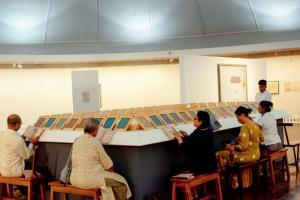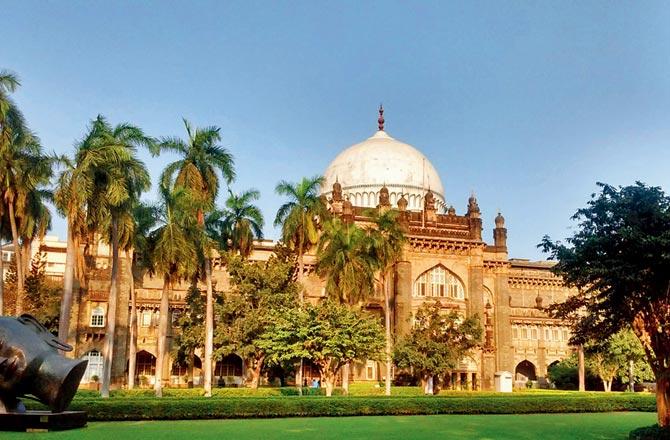
An example of an exhibition that Purohit says was thought through is Prabhakar Barwe's retrospective, Inside the Empty Box, curated by Jesal Thacker at NGMA Mumbai in February 2019. Pic courtesy/Bodhana Arts and Research Foundation
 Visual artist Nikhil Purohit, 35 is unhappy, and the lack of mobility during COVID times is not the cause. The unease is about the conclusions he has arrived at in the research (initiated last June) on visitors' accessibility in contemporary art exhibitions and programming in 74-odd visual arts organisations in Greater Mumbai metropolitan region. His findings clearly state that the visual arts world operates in a closed circuit; its programming is mostly operational in the English language, thereby limiting entry and access to those who communicate in other local Indian tongues. With a few exceptions to the rule—Dr Bhau Daji Lad Mumbai City Museum's free-to-public programming in Marathi—the entire art activity in Mumbai rests on exclusion, not inclusion.
Visual artist Nikhil Purohit, 35 is unhappy, and the lack of mobility during COVID times is not the cause. The unease is about the conclusions he has arrived at in the research (initiated last June) on visitors' accessibility in contemporary art exhibitions and programming in 74-odd visual arts organisations in Greater Mumbai metropolitan region. His findings clearly state that the visual arts world operates in a closed circuit; its programming is mostly operational in the English language, thereby limiting entry and access to those who communicate in other local Indian tongues. With a few exceptions to the rule—Dr Bhau Daji Lad Mumbai City Museum's free-to-public programming in Marathi—the entire art activity in Mumbai rests on exclusion, not inclusion.
Even before Purohit embarked on the study—which focuses on 16 defining institutions and 22 key voices of Mumbai's art world—the choice of a single instructional language for art appreciation had always bothered him. In his student days at the Sir JJ School of Art, or even during his primary schooling in Pune after his parents migrated from Hubli in the late nineties, the Kannadiga, who struggled with Marathi, has empathised with language issues. "When people are cut off from a discourse, they lose interest. I have sensed that frustration amongst fellow students from mofussil Maharashtra who couldn't spell Nietzsche or get Kant." He says a similar frustration keeps people out of art exhibitions.
ADVERTISEMENT

Mumbai's iconic Chhatrapati Shivaji Maharaj Vastu Sangrahalaya, an open-to-all welcoming space, set against an extensive garden, which retains its original plan, is a heritage precinct and is one of India's premier cultural institutions
Purohit's current study factors in a sizeable Mumbai population, which is left out of the visual art ecosystem. His interviewees—ranging from gallerist Mortimer Chatterjee, artist Vidya Kamat, curator Jesal Thacker—underscore the importance of linguistic mediation to include viewers into the discourse; a subject oft-debated, but still unaddressed. Art historian Satyajit Dave nails down the jargon-heavy complex curatorial notes and wall texts, which put off viewers in many galleries. He insists on easy-to-read simple language, which can be further decoded by the curator during much-needed walkthroughs. In the context of good viewer-curator communication, Dave recommends that artworks be placed at an average height between 53 to 60 inches, which enables exploration. As most Indian curators are short, it is challenging in a set up where the average (European) height of the patron is above six feet, Dave observes.
Dr Sudhir Patwardhan makes a valid observation about the artist's linguistic accessibility. First, he thinks mere replacement of English is not the issue; articulation of concepts in regional idioms also has to evolve. At present, artists are not equipped to communicate in an expressive regional channel. Second, artists (English speakers or otherwise) must be encouraged to write about their creative process, so that they know what it means to explain in lay person terms. Dr Patwardhan, a practising radiologist until five years ago, attributes his connect with the viewer "primarily through the patients who came to me for check-ups." These real people populated around 80 portraits in his recent retrospective, curated by Nancy Adajania, at Mumbai's National Gallery of Modern Art, on display a few months before COVID-19 axed the city's cultural calendar.

Nikhil Purohit
Purohit's interviews of art viewers/patrons, conducted in person and through Google reviews, point at the lack of available signage, wall text, info graphics, maps and labels in the local lingo of Mumbai. He also feels people often visit galleries as a touch-and-go-routine; they spend very little time in the dedicated space. These patrons need to be specially invited for a deeper inquiry, and that can only happen if exhibitions are guided in an identifiable language. Purohit, an active advocate of the use of regional languages, featured in a series of 'Kala Samvad' on the Art Katta video channel. In his work at Faandee Arts Archival Documentation and Research, he recently led a three-day webinar on the art practice and semiotics of Prabhakar Barwe, which explained (in Marathi) human perception through the prism of an artist's jottings on visual thinking. Interestingly, he enjoys a command over four languages, which complements his work at the Mohile Parikh Centre since 2012.
Access is a multi-layered notion, language access being just one box ticked, if at all, by art organisations. But, Mumbai's art world lacks in other realms as well, demonstrates Purohit's research. For instance, the unfair geographic concentration of art organisations/museum spaces in South Mumbai. It calls upon the average Mumbaikar to travel considerably to catch up with visual art endeavours. Maximum contemporary visual art activity is limited to South-Mumbai, succeeded by mid-town—Worli, Lower Parel, and Byculla—followed by some corporate and smaller art organisations in Thane-Mulund, and Borivli region. But, places like Navi Mumbai or Vasai-Virar do not display any active visual arts scene.
In another context, exhibition spaces often unknowingly deny accessibility to the physically-visually challenged viewers. Few institutions think of wheel chair mobility at the time of designing-building art spaces.
Purohit has sampled a variety of institutions—as diverse as India Art Festival, Dharavi Art Room, Nehru Centre, Saffron House and Vasai Vikasini College—so that the role of real estate valuation is evident in the scale/rating of the art endeavour. Also, one sees the differentiation between public and private bodies; that acknowledges the heavy lift arts programming involves in a city where land is costlier than gold. For any arts activity, even centres run by corporate houses like Piramal and Godrej, the commercial implications of rental costs, electricity, hospitality, and taxes, are killing.
Purohit notes that 90.5 per cent of the listed agencies operate with pertinent business, cultural, and diplomatic interests. It manifests in their attitudes to varied audiences. For example, children are welcome at Chhatrapati Shivaji Maharaj Vastu Sangrahalaya, but residency spaces and auction houses operate in a narrower compass. It also explains why school managements have few go-to choices for annual art excursions. Schools are, anyway, too short-staffed for elaborate art gallery tours. Currently, Maharashtra has discontinued new full time appointments of art educators in schools. The government has reduced the engagement with art teachers by reducing the number of art classes. It was a cost-saving measure, but that which deprived students of a personality development tool at a formative juncture! The education reforms, recently announced by the Centre, may bring some change in the scenario.
Viewers' accessibility, in general and more so in post COVID-19 times, is a demanding idea. Purohit underlines the collective thinking that is required for genuine engagement—online and offline. We are reminded that the future is not just about uploading 360 degree virtual tours on social media properties. Arts programming is akin to hosting a party in which all guests feel attended to.
Sumedha Raikar-Mhatre is a culture columnist in search of the sub-text. You can reach her at sumedha.raikar@mid-day.com
Keep scrolling to read more news
Catch up on all the latest Mumbai news, crime news, current affairs, and a complete guide from food to things to do and events across Mumbai. Also download the new mid-day Android and iOS apps to get latest updates.
Mid-Day is now on Telegram. Click here to join our channel (@middayinfomedialtd) and stay updated with the latest news
 Subscribe today by clicking the link and stay updated with the latest news!" Click here!
Subscribe today by clicking the link and stay updated with the latest news!" Click here!







